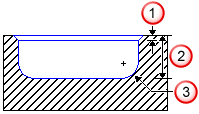The Pocket feature creates a pocket of any shape. If you want to create a simple pocket with a rounded-rectangular cross-section, use the Rectangular Pocket feature. A Pocket can have an arbitrary number of islands within the outer boundary.

 — Chamfer
— Chamfer
 — Depth
— Depth
 — Bottom radius
— Bottom radius
Warning: The island curves must be contained within the boundary curve and the island curves may not touch.
FeatureCAM follows this general process:
- Conducts an analysis of the curve and using tool diameter and length as the selection criteria, selects a tool from the current tool crib.
- For tool diameter, FeatureCAM analyzes the curve that defines the pocket to determine what size tool to use. FeatureCAM uses the largest tool that can fit in the corner and the tightest passage of the feature. The largest tool that can cut the pocket without gouging is selected (See Tool % of arc radius).
- For tool length, FeatureCAM picks a tool that has flutes long enough to cut to the bottom of the pocket.
- Chooses feeds and speeds using the Feed/Speed database that you can customize. Feeds and speeds are determined based upon the stock material.
- Performs a roughing pass, possibly in multiple Z steps based on the height of the boss.
The important aspects of roughing are:
- Getting to depth — The tool must get to depth, and this can be accomplished by a zigzag in Z (the default setting and influenced by Max ramp angle), by plunging, or by pre-drilling (see Pre-drill diameter and Pre-drill point).
- Vertical step — The rough pass can have vertical steps with cut depth not more than 100% of the tool radius (see Rough depth and Rough pass Z increment).
- Horizontal stepover — FeatureCAM moves over laterally a percentage of the tool diameter (controlled with Rough pass %), as it steps across the feature.
- Finish allowance — The rough pass contains a Finish allowance attribute which controls how much material to leave for the finishing pass. By default this is 0.02.
- Generates a finishing pass. By default, the bottom is not finished. The roughing tool removes all of the material in Z. This is controlled by
Finish bottom.
The important aspects of finishing are:
- Tool selection — After the roughing pass, the roughing tool is used to finish the pocket. Use Finish Tool commands FeatureCAM to choose a separate finishing tool (that has the same characteristics unless you override them).
- Ramp on — The finish pass ramps into the material with an arc equal to a percentage of the tool diameter (see Ramp diameter).
- Finish passes and overlap — The tool goes around the pocket a number of times set by Finish passes, and overlaps the starting point by an amount controlled by Finish overlap.
- Ramp off — Uses another arc of the same size as the ramp on to move the tool away from the finished wall.
- Retract — Removes the tool from the stock area and sets up for the next operation.
You can edit this process in these places:
- To edit all instances of this type of feature in the current document, use the Machining Attributes dialog.
- To edit a single feature, use the Tools, Milling, Strategy, and Misc. tabs for the feature in the Feature Properties dialog.
The tooling database also has a large impact on how a feature is machined, and the feed/speed database helps to determine the feeds and speeds used.